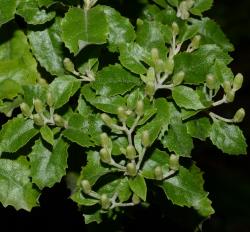- Taxon
- Gallery
Classification
Class
Order
Family
Subordinate Taxa
Nomenclature
Scientific Name:
Brachyglottis perdicioides (Hook.f.) B.Nord., Opera Bot. 44: 30 (1978)
Synonymy:
- ≡ Senecio perdicioides Hook.f., Bot. Antarct. Voy. II. (Fl. Nov.-Zel.) Part I, 149 (1852)
- = Senecio multinerve Colenso, Trans. & Proc. New Zealand Inst. 25: 330 (1892 [1893])
- = Senecio tripetaloides Colenso, Trans. & Proc. New Zealand Inst. 31: 272 (1899)
Vernacular Name(s):
Pua rangitoto; Raukūmara
Description
Shrub up to 2 m. tall; branchlets slender, pubescent, striate. Lvs glab., membr., 2.5–5 × 2 cm., on slender petioles c. 1 cm. long, oblong to elliptic-oblong, rather finely crenate-serrate. Corymbs crowded; lower bracts foliaceous; capitula c. 12, up to 1 cm. diam., turbinate, on slender pubescent pedicels. Ray-florets few (us.1–3), ligules yellow, 7·5 mm. long, broad. Phyll. oblong, midrib pubescent, margins broad, scarious. Achenes angled, pubescent, .becoming nearly glab., 2–2.5 mm. long; pappus-hairs stiff, slender, up to 5 mm. long, finely barbellate.
[From: Allan (1961) Flora of New Zealand. Volume 1 as Senecio perdicioides Hook.f.]
Biostatus
Indigenous (Endemic)
| Category | Number |
|---|---|
| Indigenous (Endemic) | 2 |
| Total | 2 |
Bibliography
Colenso, W. 1893: Phænogams: A description of some newly-discovered Indigenous plants; being a further contribution towards the making known the botany of New Zealand. Transactions and Proceedings of the New Zealand Institute 25: 324–338.
Colenso, W. 1899: Phænogams: A description of a few more newly discovered indigenous plants; being a further contribution towards the making known the botany of New Zealand. Transactions and Proceedings of the New Zealand Institute 31: 266–281.
Connor, H.E.; Edgar, E. 1987: Name changes in the indigenous New Zealand flora, 1960–1986 and Nomina Nova IV, 1983–1986. New Zealand Journal of Botany 25: 115–170.
de Lange, P.J.; Norton, D.A.; Courtney, S.P.; Heenan, P.B.; Barkla, J.W.; Cameron, E.K.; Hitchmough, R.; Townsend, A.J. 2009: Threatened and uncommon plants of New Zealand (2008 revision). New Zealand Journal of Botany 47: 61–96. [Naturally uncommon]
de Lange, P.J.; Norton, D.A.; Heenan, P.B.; Courtney, S.P.; Molloy, B.P.J.; Ogle, C.C.; Rance, B.D. 2004: Threatened and uncommon plants of New Zealand. New Zealand Journal of Botany 42(1): 45–76.
de Lange, P.J.; Rolfe, J.R.; Barkla J.W.; Courtney, S.P.; Champion, P.D.; Perrie, L.R.; Beadel, S.N.; Ford, K.A.; Breitwieser, I.; Schönberger, I.; Hindmarsh-Walls, R.; Heenan, P.B.; Ladley, K. 2018: Conservation status of New Zealand indigenous vascular plants, 2017. New Zealand Threat Classification Series. No. 22. [Nationally Critical]
de Lange, P.J.; Rolfe, J.R.; Champion, P.D.; Courtney, S.P.; Heenan, P.B.; Barkla, J.W.; Cameron, E.K.; Norton, D.A.; Hitchmough, R.A. 2013: Conservation status of New Zealand indigenous vascular plants, 2012. New Zealand Threat Classification Series 3. Department of Conservation, Wellington. [Naturally Uncommon]
Hooker, J.D. 1852–1853 ("1853"): The Botany of the Antarctic Voyage of H.M. Discovery Ships Erebus and Terror in the Years 1839–1843, under the command of Captain Sir James Clark Ross. II. Flora Novae-Zelandiae. Part I. Flowering plants. Lovell Reeve, London.
Nordenstam, B. 1978: Taxonomic studies in the tribe Senecioneae (Compositae). Opera Botanica 44: 1–83.




